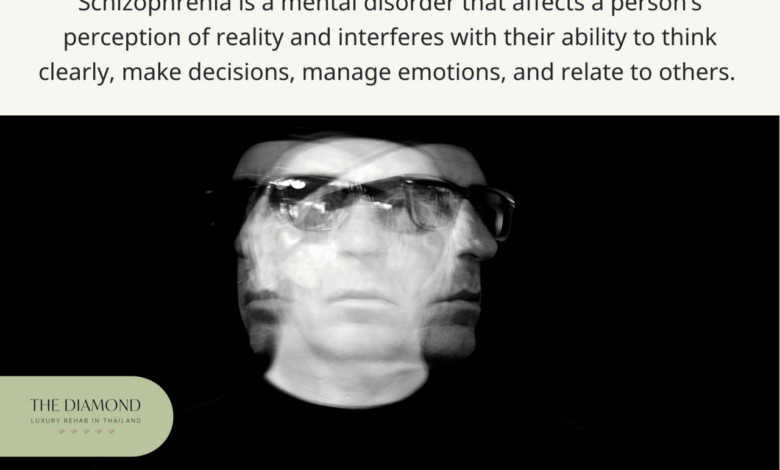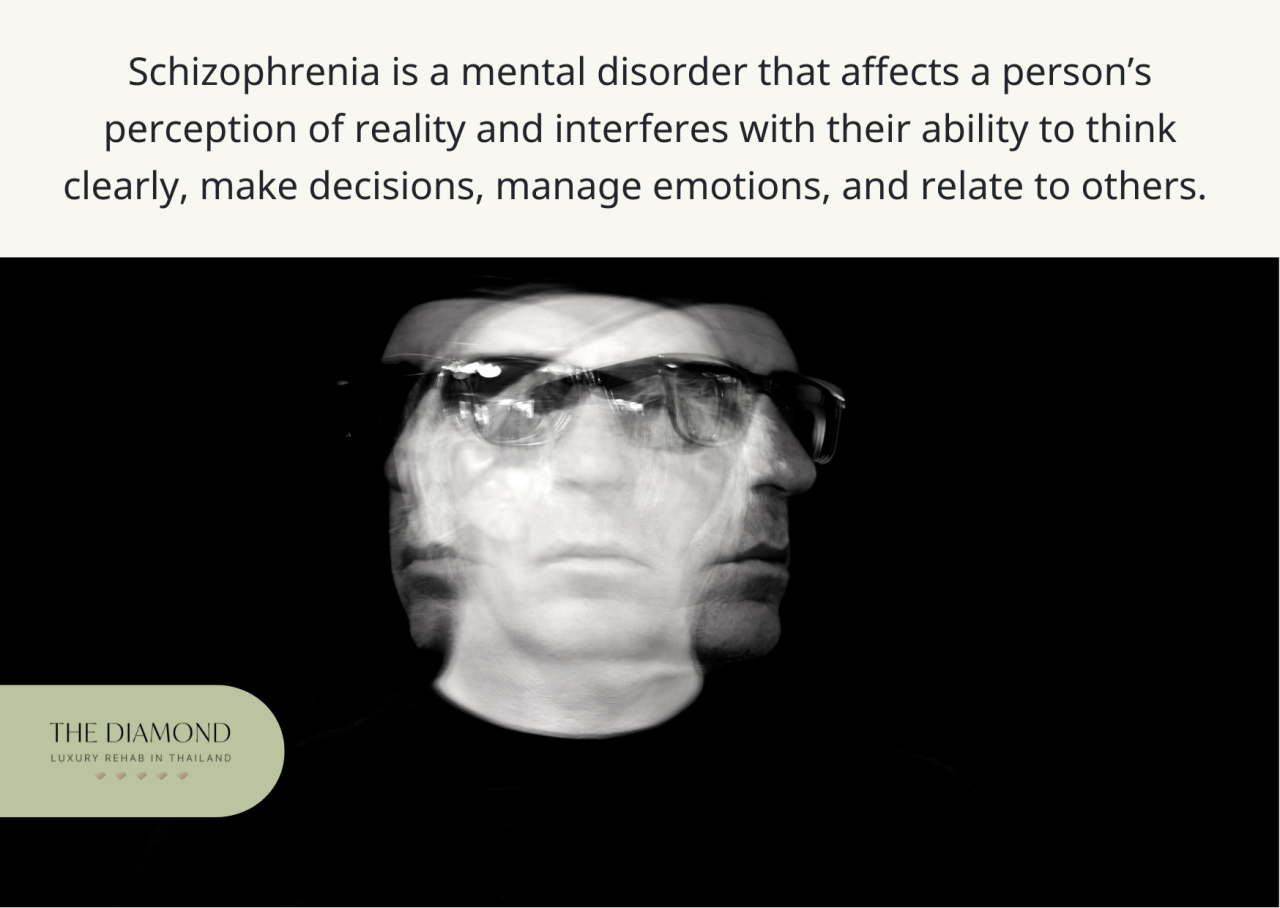
What is schizophrenia like? This exploration delves into the complexities of this mental health condition, shedding light on its various facets. From understanding the basic symptoms and types to examining the impact on daily life, treatment options, and common misconceptions, this comprehensive overview aims to provide a nuanced understanding of schizophrenia.
We’ll explore the diverse ways schizophrenia manifests, considering the range of experiences and challenges individuals face. We’ll also examine the importance of support systems, treatment approaches, and strategies for addressing the stigma surrounding this condition.
Understanding the Basics
Schizophrenia is a chronic mental disorder that affects a person’s ability to think, feel, and behave clearly. It’s characterized by a range of complex symptoms that can significantly impact daily life. Understanding the basics of schizophrenia is crucial for recognizing the signs and providing appropriate support.
Definition of Schizophrenia
Schizophrenia is a severe mental disorder characterized by disturbances in thought, perception, emotion, and behavior. Individuals with schizophrenia may experience a range of symptoms, often fluctuating in intensity and duration. These symptoms can significantly impair their ability to function in daily life, including work, relationships, and self-care.
Key Symptoms of Schizophrenia
Symptoms of schizophrenia are categorized into positive, negative, and cognitive symptoms. Understanding these categories helps in identifying and managing the condition effectively.
- Positive Symptoms: These are noticeable excesses or distortions of normal functions. They include hallucinations (experiencing sensory perceptions that are not real, such as hearing voices), delusions (strongly held beliefs that are not based in reality, such as believing one is being followed or controlled), disorganized thinking and speech (difficulty organizing thoughts and expressing them coherently), and abnormal motor behavior (unusual movements or postures).
- Negative Symptoms: These represent a decrease or absence of normal functions. Examples include diminished emotional expression (reduced range of emotional responses), avolition (lack of motivation or drive), alogia (reduced speech output), anhedonia (inability to experience pleasure), and asociality (withdrawal from social interactions). Negative symptoms can be particularly challenging to treat, as they often lead to significant functional impairment.
- Cognitive Symptoms: These are impairments in higher-level thinking processes. They include problems with attention, working memory, executive functioning (planning and decision-making), and processing speed. These cognitive deficits can significantly impact a person’s ability to function in daily life and maintain independence.
Types of Schizophrenia (If Any)
While the term “types” of schizophrenia is somewhat outdated, there are subtypes that used to be recognized, such as paranoid schizophrenia, disorganized schizophrenia, catatonic schizophrenia, undifferentiated schizophrenia, and residual schizophrenia. These subtypes are based on the predominant symptoms observed in individuals. However, the current diagnostic approach emphasizes the specific constellation of symptoms present rather than classifying into strict subtypes.
Prevalence of Schizophrenia
The prevalence of schizophrenia varies across different populations. Studies show that schizophrenia affects approximately 0.3-0.7% of the global population. The rates may vary slightly depending on geographic location and socioeconomic factors. The condition can affect individuals of all races, ethnicities, and socioeconomic backgrounds. Factors influencing prevalence remain an area of ongoing research.
Factors Contributing to Schizophrenia
Several factors may contribute to the development of schizophrenia.
| Category | Factors |
|---|---|
| Genetic Predisposition | Family history of schizophrenia is a significant risk factor. Individuals with a family member diagnosed with schizophrenia have a higher likelihood of developing the condition themselves. Genetic variations may increase susceptibility. |
| Environmental Factors | Prenatal exposure to infections or stressors, complications during birth, and exposure to toxins or environmental stressors after birth are all potential factors. Social and psychological stressors during childhood and adulthood may also play a role. |
| Neurobiological Factors | Neurochemical imbalances, particularly involving dopamine, have been implicated in the development of schizophrenia. Structural and functional abnormalities in the brain, such as enlarged ventricles or reduced gray matter, have also been observed in individuals with schizophrenia. |
Symptoms and Experiences
Schizophrenia is a complex and multifaceted mental disorder that profoundly impacts a person’s life. Understanding the range of symptoms and experiences is crucial for empathy and support. It’s important to remember that each individual’s experience with schizophrenia is unique, and symptoms can vary greatly in intensity and presentation.Schizophrenia often involves a combination of positive and negative symptoms, along with cognitive impairments.
Positive symptoms, such as hallucinations and delusions, are experiences that seem to be added on to a person’s normal state. Negative symptoms are experiences that seem to be absent, such as reduced emotional expression or motivation. Cognitive impairments, affecting thought processes and memory, can also significantly impact daily life. These varied experiences can create a complex and challenging reality for individuals living with schizophrenia.
Types of Hallucinations and Delusions
Hallucinations are sensory experiences that occur in the absence of external stimuli. They can involve any of the senses, but auditory hallucinations are particularly common in schizophrenia. These might manifest as voices commenting on the person’s actions, arguing with them, or giving instructions. Visual hallucinations, while less frequent, can involve seeing things that aren’t there. Tactile hallucinations can involve sensations like being touched or having insects crawling on the skin.
Olfactory (smell) and gustatory (taste) hallucinations are less common but can still occur.Delusions are fixed, false beliefs that are not based in reality. They can vary widely. Examples include persecutory delusions (belief that others are plotting against them), grandiose delusions (belief of having exceptional abilities or power), and referential delusions (belief that everyday events or comments are specifically directed at them).
These beliefs are deeply ingrained and resistant to evidence to the contrary. A person with schizophrenia might firmly believe that they are being monitored by a secret organization, even when presented with no evidence to support this belief.
Impact on Daily Life
The presence of hallucinations and delusions can severely disrupt daily life. The constant presence of voices or the belief that others are out to harm them can lead to social withdrawal, anxiety, and fear. Individuals might isolate themselves from friends and family, avoid social situations, or become increasingly suspicious of others. This isolation can further compound the difficulties and challenges of living with the condition.
Schizophrenia can manifest in a variety of ways, impacting a person’s thoughts, feelings, and perceptions. It’s a complex illness, often marked by hallucinations and delusions, but the experiences are incredibly diverse. Interestingly, the public health issues surrounding chronic obstructive pulmonary disease (COPD) are also a significant concern, as highlighted by Ted Koppel in his recent commentary, Ted Koppel’s piece on COPD.
Ultimately, understanding these conditions, whether mental health or physical, requires ongoing research and compassionate care.
The experience can be extremely isolating and distressing. Disrupted sleep, lack of motivation, and difficulty concentrating are all potential consequences of these experiences.
Cognitive Impairments
Cognitive impairments are an important aspect of schizophrenia. These difficulties affect a person’s ability to think clearly, process information, and make decisions. Common examples include difficulty with attention, memory, and executive functions (planning, organizing, problem-solving). Someone with schizophrenia might have trouble focusing on a task, remembering appointments, or initiating and maintaining a plan. This can severely impact their ability to function in daily life, including work, school, and personal relationships.
Cognitive impairments can often be as significant as, or even more impactful than, positive symptoms.
Varied Manifestations of Schizophrenia
Schizophrenia manifests differently in each individual. While some people experience primarily positive symptoms, others may primarily struggle with negative symptoms. The severity and frequency of symptoms also vary considerably. One person might experience profound auditory hallucinations while another might mainly struggle with flat affect (reduced emotional expression). The timing of symptom onset can also differ, affecting the course of treatment and adaptation.
This variability underscores the need for personalized care and treatment plans.
Positive vs. Negative Symptoms
| Symptom Category | Description | Examples |
|---|---|---|
| Positive Symptoms | Experiences that are added on to a person’s normal state. | Hallucinations (auditory, visual, etc.), delusions (persecutory, grandiose), disorganized thinking and speech. |
| Negative Symptoms | Experiences that seem to be absent or diminished. | Reduced emotional expression, flat affect, reduced motivation (apathy), difficulty speaking (alogia), social withdrawal. |
Positive symptoms are often more easily recognized, while negative symptoms can be more subtle and challenging to identify. Understanding the distinctions between these categories helps clinicians and support systems to develop more effective strategies for intervention and care.
Impact on Daily Life

Schizophrenia significantly impacts the daily lives of those affected, creating challenges in various aspects, from maintaining relationships to managing everyday tasks. The unpredictable nature of the illness, often involving hallucinations and delusions, can disrupt routines and social interactions. Understanding these challenges is crucial for providing effective support and improving the quality of life for individuals living with this condition.The impact of schizophrenia extends beyond the individual, affecting their families and loved ones.
The emotional toll can be immense, demanding significant coping mechanisms and resilience from everyone involved. This section will delve into the specific difficulties individuals with schizophrenia encounter, and explore the vital role of support systems in navigating these challenges.
Challenges in Maintaining Relationships
Maintaining healthy relationships is often a significant struggle for individuals with schizophrenia. The symptoms can lead to misunderstandings, social withdrawal, and difficulty communicating effectively. Delusions and hallucinations can create barriers in building and maintaining trust, making it challenging to connect with others on a meaningful level. For example, a person experiencing auditory hallucinations might perceive others as conspiring against them, leading to isolation and strained relationships.
This can be especially difficult for family members who may not fully understand the illness, and may experience frustration or anger due to the unpredictable behavior.
Difficulties in Managing Daily Tasks
Schizophrenia can disrupt daily routines and make it difficult to manage everyday tasks. Symptoms like disorganized thinking and lack of motivation can impair decision-making and organizational skills, making tasks like grocery shopping, paying bills, or maintaining personal hygiene challenging. For instance, someone experiencing difficulty with executive functions might struggle to initiate tasks or follow through with them, leading to delays in completing necessary activities.
This often necessitates assistance from family members or support systems.
Emotional Toll on Individuals and Families
The emotional burden of schizophrenia extends beyond the individual experiencing the illness. Family members and caregivers often face significant emotional distress as they navigate the complexities of the condition. They may experience feelings of guilt, frustration, and exhaustion from constantly needing to manage symptoms and provide support. Witnessing the impact of the illness on a loved one can be emotionally draining, requiring substantial coping mechanisms and support.
It’s essential to acknowledge the profound emotional toll on both the individual with schizophrenia and their families.
Importance of Support Systems
Support systems are crucial for individuals with schizophrenia. They provide a vital network of encouragement, understanding, and practical assistance. Support systems can offer emotional validation, practical guidance, and a sense of community, reducing feelings of isolation and fostering a sense of belonging. This support can encompass various forms, including family members, friends, and professional support groups.
Examples of Support Groups and Resources
Numerous support groups and resources are available to assist individuals with schizophrenia and their families. These groups offer a safe space to share experiences, receive support, and learn coping strategies. Examples include:
- National Alliance on Mental Illness (NAMI): NAMI offers a wide range of resources, including support groups, educational materials, and advocacy efforts to promote mental health awareness and support for individuals and families.
- Mental Health America (MHA): MHA provides information, support, and resources on mental health issues, including schizophrenia, and works to improve access to mental health care.
- Local community mental health centers: These centers often provide a range of services, including support groups, counseling, and medication management for individuals with schizophrenia and their families.
These organizations and resources can provide essential support, connecting individuals with valuable information, resources, and a sense of community.
Treatment and Support: What Is Schizophrenia Like
Schizophrenia is a complex mental illness requiring multifaceted approaches to treatment and support. Effective management involves a combination of medication, therapy, and a strong support network. Understanding the specific needs of each individual is crucial for tailoring a personalized treatment plan. This personalized approach often requires a team effort, involving the individual, family members, healthcare professionals, and support groups.
Treatment Options
Treatment for schizophrenia typically involves a combination of medication and therapy. Medication, often antipsychotics, aims to manage the symptoms and prevent relapses. Different types of antipsychotics have varying side effect profiles, so careful monitoring and adjustments are essential. Therapy plays a crucial role in helping individuals cope with the challenges of schizophrenia and develop effective coping mechanisms.
Cognitive Behavioral Therapy (CBT) and family therapy are often incorporated into the treatment plan to address specific needs.
Role of Family Support
Family members play a vital role in the recovery and well-being of individuals with schizophrenia. Family support encompasses providing emotional support, practical assistance, and education about the illness. This support is crucial in helping the individual navigate the challenges of daily life and maintain a sense of stability. Educating family members about the illness can empower them to understand and respond effectively to the individual’s needs, fostering a supportive and understanding environment.
Importance of Early Intervention and Diagnosis
Early intervention and diagnosis are crucial for positive outcomes in schizophrenia. Early intervention allows for prompt treatment, which can help to mitigate the severity of symptoms and improve the individual’s overall quality of life. It can also lead to a faster recovery, with fewer relapses. Early diagnosis is facilitated by recognizing the early warning signs, which can include subtle changes in behavior or mood.
By addressing the illness early, individuals can benefit from treatment that may be more effective and lead to better long-term outcomes.
Effectiveness of Therapeutic Approaches
Various therapeutic approaches can be used to manage schizophrenia. Cognitive Behavioral Therapy (CBT) focuses on identifying and modifying negative thought patterns and behaviors associated with the illness. This approach helps individuals develop coping strategies to manage symptoms like hallucinations and delusions. Family therapy aims to educate and support family members in understanding and responding to the individual’s needs.
This approach can significantly improve communication and reduce stress within the family unit. Other therapies, like social skills training and vocational rehabilitation, help individuals improve their social functioning and find meaningful employment.
Support Services
| Support Service | Description |
|---|---|
| Mental Health Clinics | Offer a range of services, including assessment, medication management, and therapy. |
| Support Groups | Provide a safe and supportive environment for individuals with schizophrenia and their families to connect with others facing similar challenges. |
| Community Mental Health Centers | Offer comprehensive services, including crisis intervention, case management, and educational resources. |
| Vocational Rehabilitation Programs | Provide support and resources for individuals to develop job skills and find employment. |
| Crisis Hotlines | Offer immediate support and guidance during times of crisis. |
| Family Support Programs | Offer education, support, and resources for family members to better understand and manage the challenges of caring for a loved one with schizophrenia. |
Misconceptions and Stigma

Schizophrenia is a complex mental health condition that often faces significant misconceptions and stigma. These negative perceptions can lead to social isolation, discrimination, and hinder access to appropriate treatment and support. Understanding the reality of schizophrenia is crucial to challenging these harmful beliefs and fostering empathy and understanding.
Schizophrenia can manifest in various ways, impacting daily life significantly. It’s a complex disorder, and navigating the challenges can feel overwhelming. Fortunately, resources like a type 2 diabetes insulin decision guide highlight the careful consideration needed for health decisions, and that same level of thoughtfulness can apply to understanding and managing schizophrenia. Ultimately, it’s crucial to seek support and information to better comprehend what schizophrenia entails.
Common Misconceptions
Many people hold inaccurate beliefs about schizophrenia, often based on misinformation or lack of understanding. These misconceptions can be deeply ingrained in societal perceptions and contribute to the stigma associated with the disorder. It is important to recognize these common misconceptions and actively work towards dispelling them.
- Schizophrenic individuals are violent and unpredictable.
- Schizophrenia is a split personality disorder.
- People with schizophrenia are incapable of leading normal lives.
- Schizophrenia is a result of personal weakness or poor choices.
Impact of Misconceptions on Stigma
The misconceptions listed above significantly contribute to the stigma surrounding schizophrenia. These beliefs lead to fear, prejudice, and discrimination against individuals with the condition. This can result in social isolation, difficulty finding employment, and limited access to housing and other essential resources. People may be wrongly perceived as dangerous or unreliable, hindering their ability to live fulfilling lives.
Challenging Misconceptions
Actively challenging these misconceptions is crucial to reducing the stigma associated with schizophrenia. Education and awareness are key components in this process. By providing accurate information and promoting empathy, we can dismantle harmful stereotypes and foster a more inclusive society.
Promoting Understanding and Addressing Stigma
Education and open dialogue are vital tools in combating stigma. Educating others about the realities of schizophrenia, through workshops, presentations, or community outreach programs, can foster understanding and empathy. Sharing personal stories of individuals living with schizophrenia can humanize the condition and challenge negative stereotypes. Supporting individuals with schizophrenia and their families is essential. Creating a supportive environment where they feel comfortable sharing their experiences can help break down barriers and promote understanding.
| Common Misconception | Accurate Information |
|---|---|
| Schizophrenia is a split personality disorder. | Schizophrenia is characterized by a range of symptoms, including hallucinations, delusions, and disorganized thinking, but it is not a split personality disorder. |
| Schizophrenic individuals are violent and unpredictable. | Studies show that people with schizophrenia are no more likely to be violent than the general population. Violence is rarely associated with the illness itself, but rather with other factors such as substance abuse or social circumstances. |
| People with schizophrenia are incapable of leading normal lives. | Many people with schizophrenia can lead fulfilling lives with appropriate treatment and support. With the right interventions, they can achieve their goals and participate in society. |
| Schizophrenia is a result of personal weakness or poor choices. | Schizophrenia is a complex brain disorder with a combination of genetic and environmental factors that contribute to its development. It is not a result of personal weakness or poor choices. |
Illustrative Case Studies
Understanding schizophrenia requires looking beyond the diagnosis and into the lives of individuals affected. Each person’s experience is unique, shaped by their specific symptoms, support system, and environment. Case studies provide valuable insights into the complexities of the condition, highlighting the challenges and successes in managing this multifaceted illness.Case studies are invaluable tools for illustrating the diverse presentations of schizophrenia, from the subtle onset to the dramatic, acute episodes.
They offer a glimpse into the individual journeys and help us better understand the impact of this disorder on daily life. By examining these real-life stories, we can gain a deeper appreciation for the challenges faced and the importance of individualized care.
Varied Presentation of Schizophrenia in One Individual
Individuals with schizophrenia experience a range of symptoms, and these symptoms can vary over time. One individual might experience predominantly positive symptoms, such as hallucinations and delusions, while another might primarily exhibit negative symptoms, such as flat affect and social withdrawal. The intensity and frequency of symptoms can also fluctuate, making consistent management a significant challenge. A patient might experience periods of relative stability punctuated by acute episodes requiring intensive intervention.
Schizophrenia can manifest in various ways, impacting daily life significantly. It’s often a complex journey of managing symptoms, and finding healthy coping mechanisms is key. Interestingly, achieving peak performance, as explored in Kerri Walsh Jennings’s insights on dieting like an Olympian kerri walsh jennings on dieting like an olympian , highlights the importance of dedication and strategy in overcoming challenges.
Ultimately, understanding and managing the complexities of schizophrenia requires a similar level of personal commitment and resilience.
The unpredictability of symptom presentation necessitates individualized approaches to care.
Challenges of Diagnosis and Treatment
Diagnosing schizophrenia can be challenging due to the overlap of symptoms with other conditions and the subjective nature of some symptoms. A thorough assessment, considering both medical and psychological factors, is crucial for accurate diagnosis. Treatment for schizophrenia involves a combination of medication and therapy. Finding the right medication and dosage can be an iterative process, requiring careful monitoring and adjustments to manage side effects and optimize effectiveness.
The patient’s motivation and adherence to the treatment plan are crucial factors affecting the outcome.
Importance of Individualized Care Plans, What is schizophrenia like
Individualized care plans are essential for tailoring treatment to the specific needs of each person with schizophrenia. This involves considering the individual’s strengths, weaknesses, preferences, and support system. An effective plan addresses not just the immediate symptoms but also long-term goals, such as vocational rehabilitation, social skills training, and independent living. A tailored plan promotes a holistic approach, encompassing the physical, emotional, and social aspects of the individual’s life.
Impact of Support System on Well-being
The support system plays a critical role in the well-being of individuals with schizophrenia. Family members, friends, and support groups can provide emotional support, practical assistance, and encouragement. A strong support network can help manage the practical challenges associated with the condition, provide a sense of belonging, and reduce the social isolation that can be a significant burden.
Strong support systems promote a sense of hope and resilience.
Successful Management Strategies
Effective management strategies for schizophrenia include a combination of medication, therapy, and support. Early intervention and consistent adherence to treatment plans are critical for achieving positive outcomes. For example, a patient who actively participates in therapy sessions, takes medication as prescribed, and actively engages with support groups is more likely to experience improved functioning and quality of life.
A structured daily routine and social engagement can also contribute to improved well-being.
Visual Representation
Understanding schizophrenia requires looking beyond the symptoms and exploring the potential biological underpinnings. This section offers visual representations to help visualize the complex interplay of brain regions, biological factors, and treatment approaches associated with the disorder. These visuals aim to provide a simplified, yet informative, understanding of the biological factors involved.
Brain Regions Potentially Affected
The brain is a complex network of interconnected regions, and schizophrenia is thought to involve dysfunction in several areas. Imagine the brain as a city with different districts responsible for various tasks. Schizophrenia might affect communication between these districts, leading to disruptions in thought processes, emotions, and perceptions. Key areas potentially affected include the prefrontal cortex (responsible for higher-level thinking), the hippocampus (involved in memory and learning), and the amygdala (crucial for processing emotions).
These areas are interconnected and their functions rely on the smooth flow of communication between them. Disruptions in this communication network can lead to the various symptoms of schizophrenia.
Biological Factors Implicated
Numerous biological factors are implicated in schizophrenia. These factors are often interconnected and may influence one another. Understanding the complexity of these factors is crucial for comprehending the disorder’s multifaceted nature.
| Biological Factor | Description |
|---|---|
| Genetics | Family history of schizophrenia significantly increases the risk of developing the disorder. Genes play a crucial role in brain development and function, and variations in certain genes may contribute to the vulnerability to schizophrenia. |
| Neurotransmitters | Neurotransmitters are chemical messengers in the brain that facilitate communication between nerve cells. An imbalance in neurotransmitters, particularly dopamine, is thought to be a key factor in schizophrenia. |
| Brain Structure and Function | Studies show differences in brain structure and function in individuals with schizophrenia, particularly in areas like the prefrontal cortex, hippocampus, and amygdala. These differences may affect the communication between different parts of the brain, leading to disruptions in thoughts, feelings, and perceptions. |
| Inflammation | Chronic low-grade inflammation in the brain may play a role in the development and progression of schizophrenia. Inflammation can damage brain cells and impair communication between them. |
| Prenatal and Perinatal Factors | Factors during pregnancy and childbirth, such as infections, malnutrition, or complications, may increase the risk of schizophrenia. |
Diagnostic Process Flowchart
A diagnosis of schizophrenia involves a careful evaluation process to rule out other conditions and determine the presence of characteristic symptoms. A doctor will follow a specific process to arrive at a diagnosis.  The flowchart illustrates the steps involved in a thorough diagnostic process, which includes initial assessment, detailed symptom evaluation, medical history review, ruling out other conditions, and the final determination of the diagnosis.
The flowchart illustrates the steps involved in a thorough diagnostic process, which includes initial assessment, detailed symptom evaluation, medical history review, ruling out other conditions, and the final determination of the diagnosis.
Types of Therapy Used in Treatment
Various types of therapy are used to help individuals with schizophrenia manage their symptoms and improve their quality of life. The choice of therapy often depends on the individual’s specific needs and preferences.  The diagram visually represents the diverse therapeutic approaches utilized in schizophrenia treatment. These include cognitive behavioral therapy (CBT), focusing on modifying thought patterns and behaviors; family therapy, involving the family in the treatment process; and social skills training, aimed at enhancing social interaction and communication.
The diagram visually represents the diverse therapeutic approaches utilized in schizophrenia treatment. These include cognitive behavioral therapy (CBT), focusing on modifying thought patterns and behaviors; family therapy, involving the family in the treatment process; and social skills training, aimed at enhancing social interaction and communication.
Role of Neurotransmitters
Neurotransmitters act as chemical messengers, transmitting signals between nerve cells. An imbalance in these chemical messengers, especially dopamine, is believed to contribute to the development of schizophrenia. Dopamine, for example, plays a crucial role in regulating movement, motivation, and reward. An excess of dopamine in certain brain regions may be linked to the positive symptoms of schizophrenia, such as hallucinations and delusions.
End of Discussion
In conclusion, understanding schizophrenia requires acknowledging its multifaceted nature. It’s a condition characterized by diverse symptoms and experiences, impacting individuals in various ways. However, with proper support, treatment, and a willingness to challenge misconceptions, individuals with schizophrenia can lead fulfilling lives. The journey toward understanding and acceptance is ongoing, and this exploration offers a valuable starting point for further learning and engagement.





